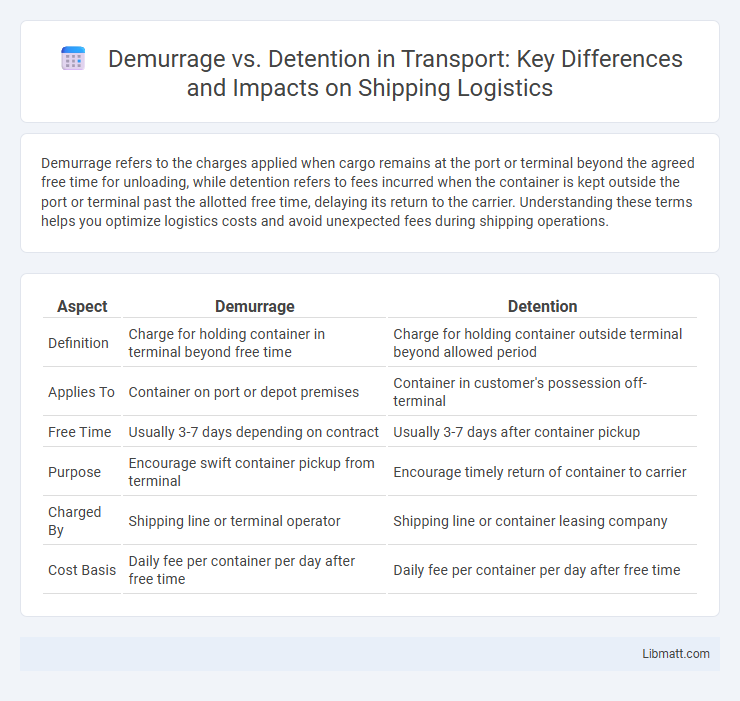Demurrage refers to the charges applied when cargo remains at the port or terminal beyond the agreed free time for unloading, while detention refers to fees incurred when the container is kept outside the port or terminal past the allotted free time, delaying its return to the carrier. Understanding these terms helps you optimize logistics costs and avoid unexpected fees during shipping operations.
Table of Comparison
| Aspect | Demurrage | Detention |
|---|---|---|
| Definition | Charge for holding container in terminal beyond free time | Charge for holding container outside terminal beyond allowed period |
| Applies To | Container on port or depot premises | Container in customer's possession off-terminal |
| Free Time | Usually 3-7 days depending on contract | Usually 3-7 days after container pickup |
| Purpose | Encourage swift container pickup from terminal | Encourage timely return of container to carrier |
| Charged By | Shipping line or terminal operator | Shipping line or container leasing company |
| Cost Basis | Daily fee per container per day after free time | Daily fee per container per day after free time |
Introduction to Demurrage and Detention
Demurrage and detention are critical charges in maritime and logistics industries, applied when containers or cargo exceed agreed time limits for loading, unloading, or return. Demurrage fees begin accruing after the free time allowed for cargo at the port terminal, while detention charges apply once the container is picked up and held beyond the allotted time outside the terminal. Understanding these terms helps you manage shipping costs and avoid unexpected expenses during your supply chain operations.
Definition: Demurrage Explained
Demurrage refers to the fee charged by a carrier to the shipper or consignee for the extended use of a shipping container beyond the agreed free time at the port or terminal. This charge compensates for delays in unloading or loading cargo, disrupting the carrier's schedule and asset utilization. Demurrage costs incentivize timely cargo handling and prevent congestion in port operations.
Understanding Detention in Shipping
Detention in shipping refers to the charges levied when cargo remains in the consignee's possession beyond the agreed free time for unloading or return of equipment, causing delays in container availability. It directly impacts your supply chain efficiency by increasing operational costs and extending turnaround times at ports or terminals. Understanding detention is essential to minimize costly delays and maintain smooth logistics flow.
Key Differences Between Demurrage and Detention
Demurrage refers to charges incurred when importers or exporters exceed the allowed free time for container storage at the port, while detention fees apply for holding the container outside the port beyond the agreed free time. You are typically charged demurrage based on calendar days the container remains in port, whereas detention fees are calculated from the time the container leaves the port until it is returned. Understanding these key differences helps optimize shipping costs and avoid unnecessary penalties in international freight logistics.
How Demurrage Fees Are Calculated
Demurrage fees are calculated based on the number of free days allowed for storage or use of shipping containers beyond the agreed period, usually starting after the vessel's arrival or the cargo release date. These fees depend on the container type, shipping line policies, and the port regulations, with charges accruing daily until the container is returned or picked up. Precise calculation involves multiplying the daily demurrage rate by the total days exceeding the free time, directly impacting overall shipping cost management.
Detention Charges: Calculation and Triggers
Detention charges are calculated based on the time a container is held beyond the agreed free time for using equipment outside the port, typically charged per day or hour. Triggers for detention include delays in unloading or returning containers, customs hold-ups, or inefficient logistics causing extended use of the container. Understanding detention charges helps shippers optimize supply chain timelines and reduce unnecessary fees.
Impact of Demurrage and Detention on Supply Chains
Demurrage and detention fees significantly affect supply chains by increasing operational costs and causing delays in cargo movement. These charges arise when containers exceed free time periods at ports or during transportation, disrupting inventory flow and production schedules. Your efficient management of demurrage and detention can mitigate risks, improve supply chain fluidity, and enhance overall logistics performance.
Strategies to Avoid Demurrage and Detention Charges
Implement clear communication with shipping lines and port authorities to ensure timely container pickup and return, minimizing demurrage and detention risks. Optimize your supply chain scheduling by accurately forecasting arrival times and coordinating transport to prevent unnecessary storage fees. Monitoring container status through tracking systems empowers you to take proactive actions that avoid costly demurrage and detention charges.
Common Mistakes Leading to Extra Charges
Common mistakes leading to demurrage and detention charges include miscalculating free time periods, resulting in delays beyond allowed limits for container use or port storage. Failing to coordinate timely container pickup and return often causes unnecessary detention fees, while improper documentation or communication with carriers can escalate demurrage costs. Understanding the distinct definitions--demurrage applies to port storage time, while detention covers container use outside the port--is crucial to avoid costly errors.
Best Practices for Efficient Container Management
Efficient container management requires understanding the distinction between demurrage and detention fees to avoid extra costs. Demurrage charges apply when containers remain in the port beyond the allotted free time, while detention fees incur when containers are held outside the port past the allowed period. You should monitor container timelines closely and coordinate with carriers to optimize pickup and return schedules, minimizing delays and associated penalties.
demurrage vs detention Infographic

 libmatt.com
libmatt.com